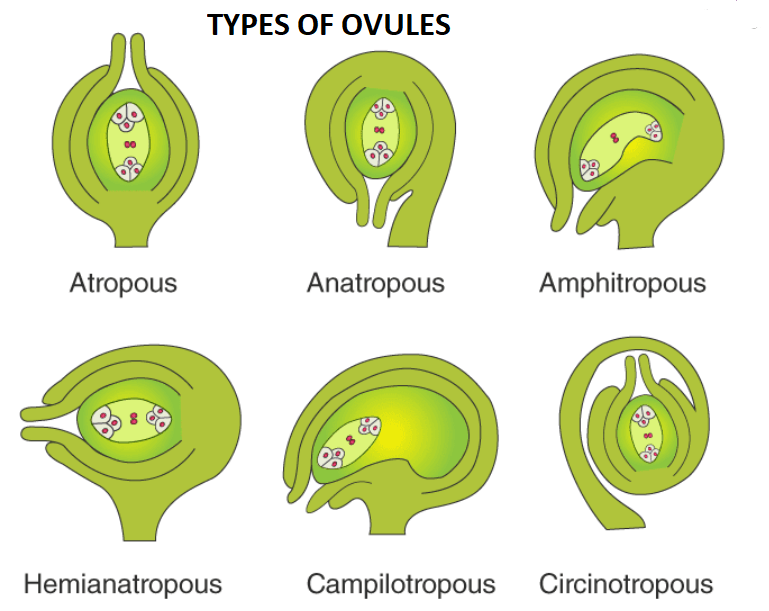
Describe types of ovules diagrammatically.
Answer
489.9k+ views
Hint: The ovule is a component of flowering plants that is found inside the gynoecium, which is the flower's female portion. Ovules in the ovary are found to be connected to the placenta by a stalk-like structure. After fertilisation, ovules become seeds.
The embryo sac is present in angiosperm, and after the fusing of the male gametes, it may result in endosperm, which ultimately feeds the children.
Complete answer:
Ovules can be generated in six different ways in Angiosperms. These are the
1. Orthotropous- The micropyle, chalaza, and funicle all lie in one straight line in an orthotropous ovule. Polygonaceae, Piperaceae, and most gymnosperm ovules are examples.
2. Anatropous (Inverted)- The ovule's body is entirely inverted, bringing the micropyle and hilum very close together. This form of ovule can be found in 82 percent of angiosperm families. Plants belonging to the gamopetalae sub-class are an example.
3. Campylotropous- The micropyle is oriented towards chalaza when the ovule is bent. Chalaza is perpendicular to the funicle. Members of the Cruciferae and Leguminosae families, for example.
4. Amphitropous or transverse ovule- The ovule curvature increases, and the embryo sac takes on a horseshoe form. Alismataceae and Butomaceae, for example.
5. Hemianatropous-When the nucellus and integuments are almost perpendicular to the funicle. For instance, the Ranunculaceae and Primulaceae families.
6. Circinotropous- Except for a small section at the end of the funicle, the funicle is extraordinarily lengthy and makes a complete circle around the ovules, which are free of it.Opuntia and other members of the Cactaceae and Plumbaginaceae families are examples.

Note:
The ovules of angiosperms, which are flowering plants, are covered. This stock, which is also known as the funicle or funiculus, connects the placenta of the overview to the placenta. The hilum is the point where the funiculus connects to the ovule's structure. The outer and inner into comment, as well as an embryo sac that is covered inside it, are all present. The nucellus is the part of the embryo sac that lies between the outer and inner integuments. Except for some of the higher sections, which are known as the micropyle, the integument covers the entire nucleus.
The embryo sac is present in angiosperm, and after the fusing of the male gametes, it may result in endosperm, which ultimately feeds the children.
Complete answer:
Ovules can be generated in six different ways in Angiosperms. These are the
1. Orthotropous- The micropyle, chalaza, and funicle all lie in one straight line in an orthotropous ovule. Polygonaceae, Piperaceae, and most gymnosperm ovules are examples.
2. Anatropous (Inverted)- The ovule's body is entirely inverted, bringing the micropyle and hilum very close together. This form of ovule can be found in 82 percent of angiosperm families. Plants belonging to the gamopetalae sub-class are an example.
3. Campylotropous- The micropyle is oriented towards chalaza when the ovule is bent. Chalaza is perpendicular to the funicle. Members of the Cruciferae and Leguminosae families, for example.
4. Amphitropous or transverse ovule- The ovule curvature increases, and the embryo sac takes on a horseshoe form. Alismataceae and Butomaceae, for example.
5. Hemianatropous-When the nucellus and integuments are almost perpendicular to the funicle. For instance, the Ranunculaceae and Primulaceae families.
6. Circinotropous- Except for a small section at the end of the funicle, the funicle is extraordinarily lengthy and makes a complete circle around the ovules, which are free of it.Opuntia and other members of the Cactaceae and Plumbaginaceae families are examples.

Note:
The ovules of angiosperms, which are flowering plants, are covered. This stock, which is also known as the funicle or funiculus, connects the placenta of the overview to the placenta. The hilum is the point where the funiculus connects to the ovule's structure. The outer and inner into comment, as well as an embryo sac that is covered inside it, are all present. The nucellus is the part of the embryo sac that lies between the outer and inner integuments. Except for some of the higher sections, which are known as the micropyle, the integument covers the entire nucleus.
Recently Updated Pages
The number of solutions in x in 02pi for which sqrt class 12 maths CBSE

Write any two methods of preparation of phenol Give class 12 chemistry CBSE

Differentiate between action potential and resting class 12 biology CBSE

Two plane mirrors arranged at right angles to each class 12 physics CBSE

Which of the following molecules is are chiral A I class 12 chemistry CBSE

Name different types of neurons and give one function class 12 biology CBSE

Trending doubts
Which are the Top 10 Largest Countries of the World?

What are the major means of transport Explain each class 12 social science CBSE

Draw a labelled sketch of the human eye class 12 physics CBSE

Differentiate between insitu conservation and exsitu class 12 biology CBSE

The computer jargonwwww stands for Aworld wide web class 12 physics CBSE

State the principle of an ac generator and explain class 12 physics CBSE




